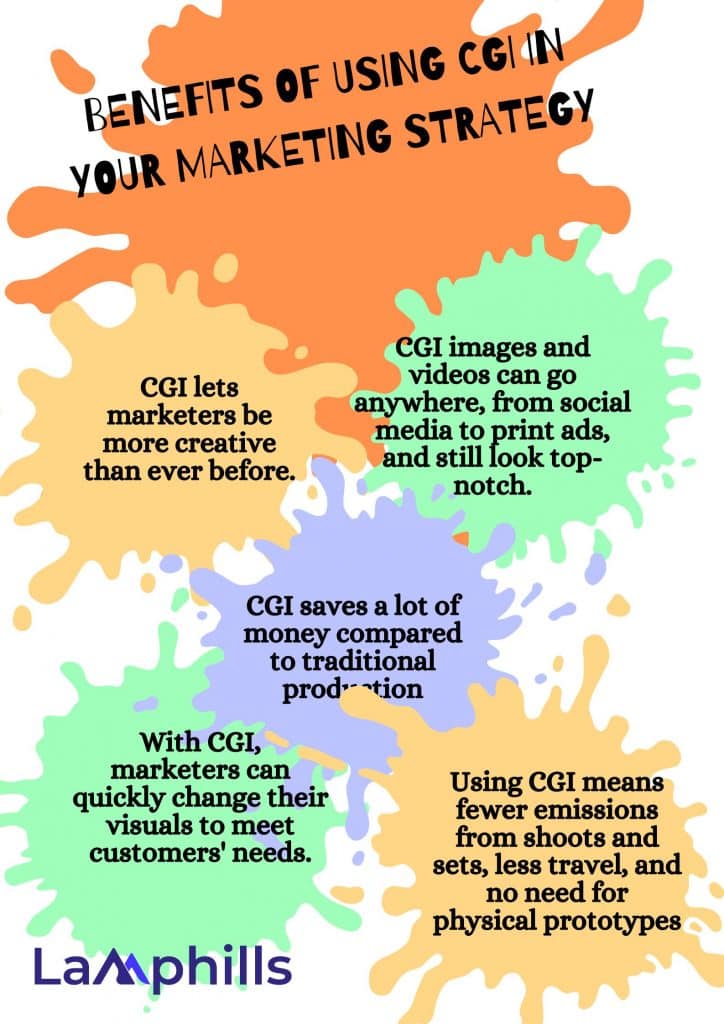Have you ever been captivated by an advertisement featuring surreal, eye-popping visuals that seem almost too perfect to be real? That’s the magic of CGI (Computer-Generated Imagery) marketing at work. As a marketer passionate about blending technology and creativity, I’ve had the exciting experience of plunging into CGI marketing. Let me tell you, it’s a game-changer. Curious to learn more? Stay tuned as we unravel the secrets behind CGI marketing and discover how you can harness its power to create unforgettable campaigns. Ready to explore? Let’s dip in!
Key Points
- CGI marketing revolutionizes brand storytelling with CGI tools like Adobe After Effects, creating immersive campaigns with lifelike visuals.
- Key CGI tools, such as Autodesk Maya and Blender, empower marketers to craft realistic worlds and fast, free creations efficiently.
- CGI marketing trends, such as AR/VR integration, realistic human models, and interactive 3D content, enhance brand engagement and storytelling.
- AI-generated content streamlines CGI production, automating tasks, improving realism, and effectively personalizing experiences for diverse audiences.
- Industry-specific applications of CGI, especially in social media marketing, offer innovative opportunities to create immersive brand experiences.
What is CGI
CGI, or Computer-Generated Imagery, is a technology that helps make or change images using computers. In advertising, CGI is like a magic tool. It lets creators design amazing, realistic scenes that can’t be easily captured with a camera. For example, if you want to show a car driving on the moon, CGI can make that happen, even though it’s impossible to film in real life. This technology makes ads more exciting and visually impressive.
CGI Marketing
CGI marketing uses computer technology to create or alter images and videos for advertising. This means marketers can design amazing scenes and products that look incredibly real or fantastically imaginative, which would be hard or impossible to film in real life.
CGI Marketing Campaigns
CGI marketing campaigns use computer-generated visuals to create stunning and imaginative advertisements. These campaigns can depict anything from realistic scenes to fantastical worlds, capturing viewers’ attention and making a lasting impact.
CGI Marketing Tools
#1. Adobe After Effects: Create Visual Masterpieces
Adobe After Effects is part of Adobe Creative Cloud and is excellent for designers creating impressive visuals. It helps animate characters, add effects like rain or fire, and explore 3D space. With its powerful features, you can quickly bring your ideas to life, from character animations to movie titles and intros. This software significantly improves the quality of any animation project.
#2. Autodesk Maya: Craft Realistic Worlds
Autodesk Maya is a user-friendly software for creating complex characters, large environments, and stunning effects. It enables the creation of high-quality visuals and lifelike characters similar to those seen in blockbuster movies. Maya offers various subscription options to fit different needs and budgets. It provides tools for modeling, animation, and realistic visuals, making it essential for design professionals.
#3. Daz Studio: Unlock the 3D Universe
Whether you’re a beginner or a pro, Daz Studio helps bring the 3D world to life. It allows you to create perfect 3D characters and environments with realistic rendering. With a vast library of free and premium 3D content, Daz Studio lets you unleash your creativity and bring your imagination to reality through renders, rigs, and poses.
#4. Blender: Fast and Free Creations
Blender is free, open-source software that helps designers create quickly and efficiently. Supported by a vibrant community, Blender includes features like V.R. rendering, realistic shading, high-quality lighting, and real-time previews. It provides all the tools needed to create impressive visuals, making it a favorite among creators for its dynamic and detailed capabilities.
#5. Pixologic ZBrush: Sculpting Digital Art
Pixologic ZBrush, developed by Maxon, is powerful 3D software for digital painting and sculpting. It offers customizable textures and brushes and allows for real-time sculpting. ZBrush is popular among jewelry designers, game developers, illustrators, and animators, enabling high-quality designs and animations with comprehensive tools.
#6. Powtoon: Compelling Visual Communications
Powtoon helps users create unique video ads, social media content, and engaging animations. With customizable features, it allows you to create compelling messages through animated characters and video backgrounds. Powtoon’s tools make attracting and retaining your target audience easy, enhancing visual communications effectively.
#7. Pencil2D Animation: Intuitive 2D Animation Tool
Pencil2D Animation is a user-friendly software for creating hand-drawn 2D animations. It is open-source and works across multiple platforms like Linux, macOS, Windows, and FreeBSD. With support for both vector and raster graphics, it allows seamless switching between the two, making it easy to let your creativity flow.
#8. Synfig Studio: Bring 2D Animation to Life
Synfig Studio is a free, open-source 2D animation software on O.S.X., Linux, and Windows. It enables designers to create impressive animations without frame-by-frame work. With advanced features like vector tweening, bones, layers, and filters, Synfig Studio efficiently produces film-quality animations and dynamic character structures.
#9. Autodesk Tinkercad: Creativity in 3D
Autodesk Tinkercad is a free, easy-to-use application for exploring 3D design, coding, and electronics. It focuses on foundational skills, allowing you to bring imaginative designs to life. By placing, adjusting, and combining shapes, Tinkercad lets you create detailed models, making it an excellent tool for diving into 3D design, electronics, coding, and augmented reality.
#10. Clara.io: Cloud-Based 3D Modeling and Rendering
Clara.io is a comprehensive, cloud-based platform for animating, modeling, and rendering images online. It offers robust modeling tools, VRay Cloud rendering, multi-platform support, easy sharing, a modern interface, and various other features. Clara.io supports multiple formats and collaboration, making it a versatile cloud-based 3D modeling and rendering tool.
Also Read: Free PR Tools: Top 10 Free PR Gems That Put Paid Tools to Shame
The Rise of CGI Marketing and Advertising
CGI stands for Computer-Generated Imagery, which means creating visual content using computers. This technique includes making 3D models, animations, and realistic images. It can create everything from fantasy worlds to very realistic product images (and even fixing Superman’s mustache in movies).
CGI is very useful in marketing campaigns. It allows marketers to visualize products and tell immersive stories in ways that were not possible before.
In the past, traditional advertising relied heavily on photography and video to show products and tell brand stories. But now, with CGI becoming more accessible, new creative opportunities have opened up that used to be only for expensive productions. Today, many brands use CGI to create visually impressive and emotionally engaging campaigns.
CGI helps advertisers create realistic virtual environments and objects that don’t exist in real life. It also makes showcasing real-world items much easier and more affordable than traditional methods like photography or videography.
What Are the Trends in CGI Marketing?
The way brands use computer-generated imagery (CGI) in marketing is constantly changing, with new trends shaping how they engage with customers and tell their stories. Here are some key trends to consider when promoting your business through CGI:
#1. Augmented Reality (A.R.) and Virtual Reality (V.R.) Integration
Augmented Reality (A.R.): A.R. overlays digital information onto the real world, enhancing what you see around you. It often uses smartphones or wearable devices to show virtual elements in real-world settings, creating interactive experiences. For example, you might use your phone to see how a new piece of furniture would look in your living room.
Virtual Reality (V.R.): V.R. immerses you in a wholly digital environment using a headset or V.R. device. It blocks out the real world, placing you in a simulated space where you can explore and interact. V.R. can be used for everything from gaming and entertainment to virtual tours and training simulations.
A.R. and V.R. can transform marketing by creating unique and memorable experiences that engage customers in new ways. As these technologies become more accessible, they offer endless possibilities for innovative marketing campaigns.
#2. Realistic Human Models
CGI technology has advanced to create hyper-realistic human models like real people. These virtual influencers or digital humans are used in various industries, such as fashion and beauty, to showcase products and engage consumers.
Digital human models are used in fashion for virtual fashion shows, digital lookbooks, and online campaigns. These models can represent diverse body types, skin tones, and styles, promoting inclusivity and creativity. In the beauty industry, CGI models are used for virtual makeup tutorials and product demonstrations, allowing brands to experiment with different looks and trends.
Using CGI models offers many benefits, including cost-effectiveness, flexibility, and the ability to create highly personalized content. Brands can produce high-quality visuals without physical photoshoots and quickly adapt their content for different platforms and campaigns.
#3. Interactive 3D Content
Interactive 3D content is becoming more popular because it offers immersive and engaging experiences. This content allows users to interact with virtual objects and environments in real-time, providing a dynamic experience that static content can’t match.
Technological advancements like faster processors and better graphics have made creating high-quality 3D animations and simulations easier. Interactive 3D content can improve user engagement and retention by allowing customers to view products from different angles, customize features, and make informed decisions.
#4. AI-Generated Content
Artificial intelligence (A.I.) plays a significant role in CGI production by making the process more efficient and innovative. A.I. tools can automate repetitive tasks, speed up production, and improve the realism of visual effects.
For example, AI can help automate lighting and texturing, making rendering faster and more consistent. A.I. can also create realistic simulations of natural phenomena, such as fluid dynamics and particle systems, enhancing the visual quality of CGI effects.
A.I. can also personalize content for different audiences by analyzing user behavior and tailoring content to individual preferences. This allows brands to deliver more targeted and engaging CGI content, driving user engagement and retention.
#5. Industry-Specific Applications
CGI is being used across various industries to drive innovation and creativity. In social media marketing, for example, CGI allows brands to create visually stunning campaigns that stand out on platforms like Instagram, Facebook, and TikTok.
- Instagram: Brands use CGI for virtual fashion shows, A.R. filters, and effects to create interactive and shareable experiences.
- Facebook: CGI is used for interactive 360-degree videos and personalized content experiences, allowing users to explore virtual environments and products wholly.
- TikTok: Brands launch CGI animation challenges and collaborate with virtual influencers to create engaging content that resonates with users.
Overall, CGI offers exciting brand opportunities to create immersive and engaging experiences. By staying ahead of these trends, brands can differentiate themselves and connect with their audiences meaningfully.
How To Make CGI Ads?
Creating CGI (Computer-Generated Imagery) ads involves several steps, including pre-production planning, 3D modeling, animation, rendering, and post-production. Here’s a step-by-step guide to help you through the process:
#1. Pre-Production Planning
Pre-production planning involves concept development, scriptwriting, and gathering references. Start by defining the purpose of your ad and the message you want to convey. Develop a storyboard outlining key scenes and actions to visually represent your concept. Write a script that aligns with your storyboard, ensuring it effectively communicates your message. Gather reference images, videos, and other materials to guide your CGI’s visual style and details.
#2. 3D Modeling
3D modeling is the process of creating the objects, characters, and environments needed for your ad. Choose appropriate 3D modeling software such as Blender, Autodesk Maya, 3ds Max, or Cinema 4D. Create detailed models, paying attention to aspects like scale and proportions. Apply textures using tools like Substance Painter or Photoshop to add color and surface detail to your models, making them look realistic and visually appealing.
#3. Rigging and Animation
Rigging involves setting up the skeletons and control handles for your models to define their movements. This is crucial for characters or any objects that need to move. Once rigged, animate your models according to the storyboard. Use keyframe animation, motion capture, or other techniques to bring your characters and objects to life. Simulations can be used for complex effects like smoke, fire, water, or cloth dynamics to add realism to your scenes.
#4. Lighting and Rendering
Lighting sets the mood and atmosphere of your scenes. Place various light sources strategically and adjust their intensity, color, and placement to achieve the desired effect. Rendering is generating the final images from your 3D models and animations. Use high-quality rendering engines like Arnold, V-Ray, or Cycles to produce photorealistic images. This stage can be time-consuming but is essential for a polished final product.
#5. Post-Production
Post-production involves compositing, editing, and color grading. Use compositing software like Adobe After Effects, Nuke, or Fusion to combine rendered elements, add visual effects, and enhance the final look. Edit the footage to align with your storyboard and script, adding transitions, music, sound effects, and voiceovers as needed. Color grading ensures tone consistency and enhances the visual appeal, making the final output more cohesive and attractive.
#6. Final Output
In the final output stage, thoroughly review your ad to identify and correct any mistakes. Export the final ad in the required format and resolution suitable for the platform on which it will be displayed, such as TV, web, or social media. Distribute your ad across the chosen platforms and monitor its performance to gauge its effectiveness. Throughout the entire process, collaboration with a team and seeking continuous feedback are key to refining and improving your CGI ad.
Check our article on PR Campaign Secrets: How Top Brands Dominate the Spotlight

The Benefits of Using CGI in Your Marketing Strategy
Using CGI in your marketing strategy isn’t just about having a new tool. It’s about changing how brands connect with their audiences.
- Unlocking creativity: CGI lets marketers be more creative than ever before. With traditional photography and video, there are lots of challenges and costs. But with CGI, those obstacles disappear. Marketers can dream up big ideas and make campaigns happen that were impossible before. CGI also lets them experiment, like creating 3D outdoor ads to replace old-fashioned billboards.
- Consistency everywhere: Today’s brands must look the same across all platforms. CGI makes that easy. CGI images and videos can go anywhere, from social media to print ads, and still look top-notch.
- Adaptable and flexible: With CGI, marketers can quickly change their visuals to meet customers’ needs. Whether updating a campaign or changing a product, CGI makes it all simple and much faster than traditional methods like photography.
- Affordable: CGI saves a lot of money compared to traditional production. Instead of spending on expensive photo shoots or location filming, marketers can do everything with CGI. Plus, it’s faster. As technology gets better and cheaper, CGI will become even more common.
- Suitable for the planet: Using CGI means fewer emissions from shoots and sets, less travel, and no need for physical prototypes. For example, car companies can make ads for new cars using CGI before being built.
Related Post
How Digital Technology Revolutionized My TV Viewing Experience
Marketing vs. Advertising: Building a Growth Engine for Your Business
Elevate Your Brand’s Marketing Strategies With PR Boxes
References






